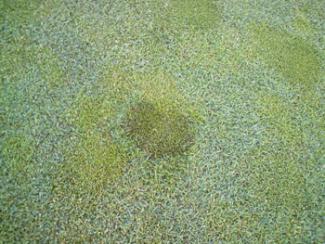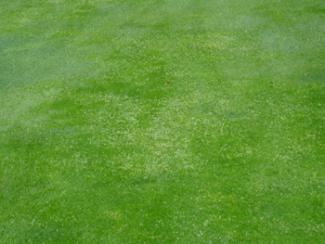Featured Golf News
Torsiello's Turf Talk: Poa Annua - the Cockroach of Grass Strains
Some superintendents hate it, some try hard to eradicate or at least control it, and others learn to live with it. What is it? Poa annua, one of the heartiest, most invasive and difficult-to-control grass types known to man.

Close-Up of Poa Annua
If, as some say, cockroaches will be the one insect species to survive a nuclear holocaust, then the one grass that could make it through such a terrible event might just be poa annua. Commonly found in both cool-season and warm-season regions where it attacks turfgrass, poa annua is hard to eliminate and seems immune to almost everything a superintendent throws at it.
Chemical and cultural techniques work to some degree, but the insidious plant seems to simply rebound no matter what is done to eradicate it. Poa annua's clumpy growth habit and fast rate of growth can significantly affect ball roll, which is why some courses mow putting greens twice a day. Also, it is generally less heat- and disease-tolerant, and in the south U.S. these clumps/patches can die or wilt, thus changing the roll of the ball.
Bruce Branham, a professor at the University of Illinois specializing in weed science, turf, water quality and soil fertility, says poa annua produces seed heads that disrupt putting green uniformity. It also requires more intensive maintenance - including frequent hand-watering or syringing - to get through "stressful" days.
"Poa produces viable seed at any cutting height and with very little time required for the seed to ripen," Branham says. "Turfgrasses produce seed, but it takes one to two months on the stalk for the seed to become viable. Not so with poa. Once poa is on the golf course, every time you mow you're overseeding with poa."
Robert Walker, professor of soils and agronomy at Auburn University, takes a more pragmatic approach to poa. "Remember, a weed is a plant we have not found a use for. There are a number of superintendents that have found a use for (poa) and thus it is not a problem," Walker notes.
The issue is compounded by golfers who have a vision of what a perfect turf is: uniform mono-stands with an excellent green color - no doubt influenced by telecasts of such tournaments as the Masters from pristine Augusta National Golf Club - where nary a weed dares raise its ugly head. Poa infestation is totally contrary to that mindset; it's characteristics are poor color, clumpiness, disease susceptibility and abundant flowers. Hence the efforts to eradicate it.
There are a number of promising products either on or soon to be on the market to help fight poa. Moghu Research Company of South Korea has launched a new herbicide in that country called PoaCure for selective poa control on bentgrass putting greens and fairways (tests in the U.S. have shown positive results). It is a post-emergence-applied herbicide with some pre-emergence activity. It controls both perennial and annual biotypes of poa. The common name of this herbicide is methiozolin.

Long-Distance View of Poa Annua
Walker claims that PoaCure will "revolutionize" poa control on bentgrass putting greens. Additionally, Bermuda grass, zoysiagrass, Kentucky bluegrass and other turfs have displayed excellent tolerance to methiozolin.
"I have also demonstrated excellent control on Bermuda grass putting greens of ALS-resistant poa. Bentgrass is the current emphasis, but as ALS resistance increases, (PoaCure) will become a valuable tool for warm-season grass managers." Moghu Research's goal is to have U. S. labeling in 2015.
Matt Shaffer, superintendent at Merion Golf Club in Ardmore, Pa., has been testing PoaCure and reports the product to be "amazing." He adds, "It takes the poa out very slowly. This way the putting surfaces aren't compromised while the bent grass grows over the spots. I have used everything and done some pretty risky things to eliminate poa. It wasn't frustrating some of the time, it was frustrating all the time.
"Some chemistries work well, but they become less effective the longer you use them and the rates get so high it is cost-prohibitive."
Xonerate (amicarbazone) also recently hit the market. It may work best on green surrounds and fairways. Turf injury is weather- and turf-maturity-dependent, but the product works well on poa. It is best to get familiar with it before large-scale use.
Dr. Fred Yelverton, professor of crop science at North Carolina State University, says the biggest issue may be whether a superintendent actually wants to kill poa annua. "This may sound odd, but in my view this is a more important question than what product to use. We are to the point (or will be very shortly) where we can take out poa annua in bentgrass. But the question is . . . do you really want that? If someone has 20 to 30 percent poa annua in bentgrass, then the decision is easier and is more likely to be `yes.' But if you have 70 to 80 percent poa annua, then the answer is more likely `no.' "
Poa competes well in wet, compacted and highly trafficked areas. Limiting nitrogen and water (especially in the heat of the summer) can give the advantage to other turfgrasses (bentgrass or Bermuda grass) as poa doesn't do well in these situations. Golfer foot and cart traffic can't easily be limited, but superintendents can concentrate on certain things, such as making putting greens bigger and moving pin placements consistently.
Supers may also want to raise mowing heights; limit nitrogen applications in the fall; keep turf dry; aerify in summer when germination is not favorable; avoid any fungicides that control anthracnose or summer patch; and limit applications of phosphorus, which promotes the rooting of young poa plants and seed-head production.
For some, it is feasible to reduce poa annua with the products on the market today, although that comes with a high yearly cost to prevent it from coming back. When stands of poa are greater than 30 to 40 percent, it may be best to do a complete renovation of the green or live with the poa and manage it to keep it alive. As of now, it is impossible to completely eradicate the problem; rather it must be managed so that it stays at acceptable levels at less than five to 10 percent, depending on the course's tolerance level.
Having a poa-free golf course can reduce the number and intensity of pesticide applications, hand-watering and other labor-intensive efforts. The savings are balanced by the cost of control, which is often substantial. In climates where ice cover is a concern, having large percentages of poa on the golf course could mean unplayable conditions and turf reestablishment if the ice cover lasts more than 40 to 45 days. A poa-free golf course will also allow for greater tolerance of drier conditions since other grasses have deeper root systems and can withstand surface dryness better than poa.
Whether you hate it, try to get rid of it or simply live with it, poa annua is one grass strain that has stood the test of time and will likely be causing superintendents fits for years to come.
John Torsiello is an editor/writer living in Connecticut. He has written extensively about all aspects of the golf industry for a number of national and regional publications. He is a regular contributor to "Golf Course Industry," "Lawn and Landscape," "Golfing" and "Fairway Living" magazines as well as various online publications. He has strong, ongoing relationships with industry professionals and has worked closely with course owners, architects, developers, course superintendents and general managers around the country. He has won a number of awards for his writing, including first place from the Turf and Ornamental Communicators Association for a piece that appeared in "Golf Course Industry" magazine.
Story Options
 |
Print this Story |
